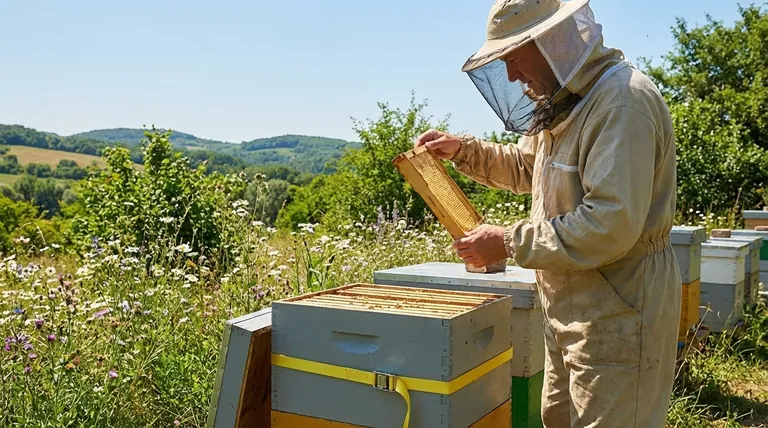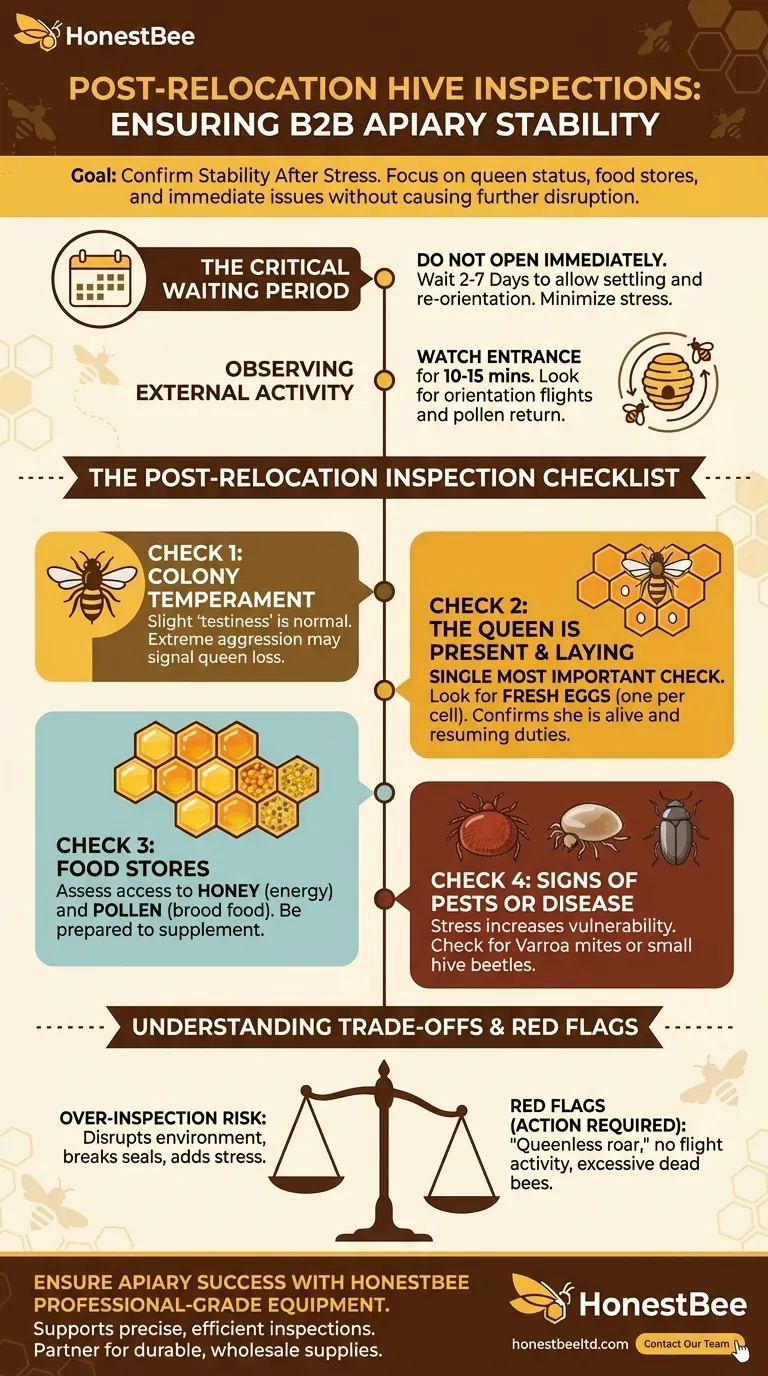To properly check a hive after relocation, you must perform a targeted inspection focused on the colony's stability, the queen's status, and any immediate signs of distress. The primary goals are to confirm the queen is safe and laying, assess the colony’s food stores, and check for stress-induced problems or pests without causing further disruption.
Relocating a beehive is inherently stressful for the colony. Your post-move inspection should not be a deep, disruptive dive, but rather a quick, systematic health check designed to confirm the colony has weathered the move and is re-orienting successfully.

The Goal: Confirming Stability After Stress
Moving a hive is a significant disruption. The bees are confined, jostled, and then released into a completely new environment, forcing them to re-learn their surroundings.
The Critical Waiting Period
Do not open the hive immediately. Give the colony at least 2-3 days, and ideally up to a week, to settle. This allows them to re-establish guard bees, begin re-orienting, and calm down from the stress of the move. Opening the hive too soon adds unnecessary stress.
Observing External Activity First
Before you ever crack the lid, watch the hive entrance for 10-15 minutes. Look for normal orientation flights—bees circling in front of the hive as they map their new location. A steady stream of bees coming and going with pollen is the best possible sign.
The Post-Relocation Inspection Checklist
When you do open the hive, your inspection should be quick and purposeful. Have your tools ready and know exactly what you are looking for to minimize the time the hive is open.
Check 1: Colony Temperament
A relocated colony may be more defensive than usual. A bit of "testiness" is normal. However, extreme aggression could signal a deeper problem, such as the loss of their queen.
Check 2: The Queen is Present and Laying
This is the single most important check. You do not need to physically find the queen. The best evidence that she is alive and well is the presence of freshly laid eggs.
Carefully and gently lift a frame from the center of the brood nest. Look inside the cells for tiny, rice-like eggs, one per cell. If you see eggs, your primary mission is accomplished. The queen survived the move and has resumed her duties.
Check 3: Food Stores
The stress of being confined and the energy required to re-orient the colony consumes resources. Quickly check a few frames to ensure the bees have adequate access to both honey (for energy) and pollen (for feeding brood). If stores are low, be prepared to provide supplementary feeding.
Check 4: Signs of Pests or Disease
Stress can make a colony more vulnerable to pests and diseases. While performing your checks, keep an eye out for pests like Varroa mites or small hive beetles. An increase in their numbers could indicate the colony's defenses have been weakened by the move.
Understanding the Trade-offs
Every hive inspection is a calculated disruption. After a move, the balance between gathering information and causing more stress is especially delicate.
The Risk of Over-Inspection
Opening the hive disrupts the colony's internal environment, breaks the propolis seals they use to keep out drafts and pests, and can agitate the bees. An inspection done too soon or too aggressively can set the colony back, prolonging their recovery from the move.
Red Flags That Demand Action
While patience is key, some signs require immediate intervention. These include a loud, continuous "queenless roar," a complete lack of flight activity after several days, or a large number of dead bees at the entrance. These symptoms point to a critical problem that outweighs the risk of an inspection.
Making the Right Choice for Your Goal
Your approach should be tailored to the specifics of the move and the initial observations you make.
- If your primary focus is minimal disruption: Rely on entrance observation for the first week. If you see normal flight patterns and pollen coming in, you can postpone a full internal inspection.
- If you see signs of disorientation (bees returning to the old site): Place a large branch or a board in front of the entrance. This forces them to re-navigate as they leave and helps reset their internal GPS.
- If you confirm the colony is queenless: You must act decisively. Re-queen the hive as soon as possible to prevent the colony from failing.
Ultimately, a successful post-relocation check is defined by patience and precision, ensuring the colony has the support it needs to thrive in its new home.
Summary Table:
| Checkpoint | What to Look For | Why It's Important |
|---|---|---|
| Colony Temperament | Slight defensiveness is normal; extreme aggression is a red flag. | Indicates stress level and potential queen loss. |
| Queen Status | Presence of freshly laid eggs (one per cell). | Confirms the queen survived and is laying. |
| Food Stores | Adequate honey (energy) and pollen (brood food). | Ensures colony has resources to recover from the move. |
| Pests & Disease | Signs of Varroa mites or small hive beetles. | Stress can weaken colony defenses against invaders. |
Ensure your apiary's success with professional-grade equipment from HONESTBEE.
Relocating hives is a high-stakes operation for commercial apiaries and distributors. Minimize colony stress and maximize survival rates with durable, well-designed beekeeping supplies built for the demands of wholesale operations. Our equipment supports the precise, efficient inspections detailed in this article, helping you protect your valuable investments.
Let HONESTBEE be your trusted wholesale partner. Contact our team today to discuss your apiary's specific needs and explore our full product catalog.
Visual Guide

Related Products
- Professional Galvanized Hive Strap with Secure Locking Buckle for Beekeeping
- Versatile Ratchet Hive Strap with S-Hooks for Secure Fastening
- Heavy-Duty Galvanized Steel W-Style Pallet Clip
- Endless Loop Ratchet Hive Strap
- Multi-Functional Rotary Hive Entrance Disc for Beekeeping
People Also Ask
- What is the best length for straps used around beehives? Why 12 Feet is the Industry Standard
- What are the two styles of hive straps? Choose the Right Strap for Your Hive Security
- What is the advantage of using cam buckle straps? Secure Your Load Fast with Simple, Safe Tensioning
- How can beekeepers secure the top cover of a hive? Protect Your Colony from Wind and Weather
- What are hive straps and why are they used? Secure Your Hives Against Wind, Predators, and Transport



















